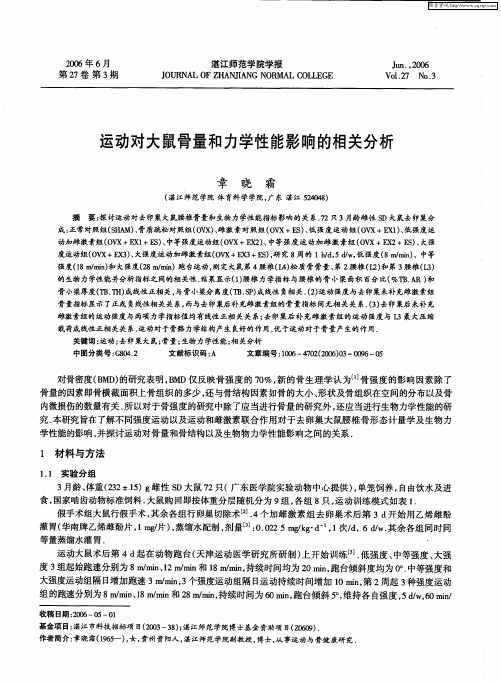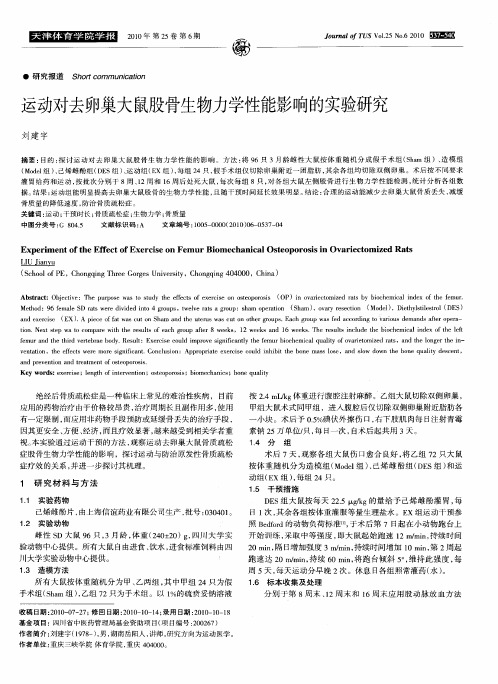运动对去卵巢大鼠骨矿含量和骨密度的影响
- 格式:pdf
- 大小:214.13 KB
- 文档页数:3

运动对去卵巢大鼠骨元素代谢的影响
张兆强;刘浩宇;刘锡仪
【期刊名称】《广东微量元素科学》
【年(卷),期】2002(009)011
【摘要】用测定骨元素含量的方法,分析了运动对正常大鼠和切除双侧卵巢后的大鼠骨元素代谢的影响.将健康4个月龄雌性SD大鼠44只随机分成5组:(1)非去势非运动组;(2)非去势+运动组;(3)假去势非运动组;(4)去势非运动组;(5)去势+运动组.运动组用大鼠专用跑台中等运动强度训练,持续10周.结果表明,去卵巢大鼠骨Ca、Mg、S、Mn、Zn等含量显著降低,P含量显著增加.运动训练可使去卵巢大鼠降低的骨Ca、Mg、S、Mn、Zn等含量显著回升,骨P含量显著回降.提示中等强度运动训练可对抗由于去卵巢所引起的骨元素代谢紊乱.
【总页数】4页(P29-32)
【作者】张兆强;刘浩宇;刘锡仪
【作者单位】广东医学院生理教研室,广东,湛江,524023;广东医学院生化教研室,广东,湛江,524023;广东医学院生理教研室,广东,湛江,524023
【正文语种】中文
【中图分类】R681
【相关文献】
1.尼尔雌醇对去卵巢大鼠骨元素代谢和相关激素含量的影响 [J], 张兆强;刘浩宇;刘锡仪
2.运动对去卵巢大鼠骨元素代谢和相关激素的影响 [J], 张兆强;刘浩宇;刘锡仪
3.运动加强氟化钠对去卵巢大鼠骨元素代谢的影响效应 [J], 张兆强
4.运动加强尼尔雌醇抗去卵巢大鼠骨元素代谢紊乱的作用 [J], 张兆强;刘浩宇;刘锡仪
5.利骨素对去卵巢大鼠矿物骨元素代谢的影响 [J], 蔡波;张兆强;刘浩宇;刘锡仪因版权原因,仅展示原文概要,查看原文内容请购买。




不同强度跑台运动对大鼠骨量的影响及机制的研究的开题报告1.研究背景和意义跑步是一种常见的运动方式,可以增强人体的心肺功能、改善身体素质和预防慢性病等。
在动物实验中,大鼠是常用的研究模型。
多项研究表明,跑步运动对大鼠的骨量有显著影响。
但是,目前相关研究较为局限,缺乏对不同强度的跑台运动对大鼠骨量的影响及机制的深入探究。
因此,本研究旨在进行不同强度跑台运动对大鼠骨量的影响及机制的研究,为进一步探究运动对骨健康的影响提供理论支持。
2.研究内容和方法本研究将选择成年雄性大鼠,采用不同强度跑台运动对其进行干预,观察其对骨量的影响及可能的作用机制。
具体研究内容和方法如下:2.1实验设计将大鼠随机分为4组,分别为对照组、低强度组、中强度组和高强度组。
对照组不进行运动干预,其他组分别在跑台上进行不同强度的运动干预。
2.2运动干预每组大鼠在跑台上运动时间为每天60分钟,持续6周。
其中,低强度组、中强度组和高强度组分别进行运动强度为60%、80%和100%的跑步训练。
2.3数据采集和处理每组大鼠在干预前和干预后,分别进行骨密度和骨强度的检测。
同时检测其血清中的相关生物指标,如骨钙素、碱性磷酸酶等。
收集数据后,将进行统计学分析和多因素回归分析,以探究跑步对大鼠骨量的影响及机制。
3.研究意义和预期结果本研究将探究不同强度跑台运动对大鼠骨量的影响及机制,对于进一步明确运动对骨健康的影响机理具有重要意义。
预期结果为:跑步运动能够显著提升大鼠的骨密度和骨强度,且运动强度与骨健康的改善存在一定的正相关关系。
同时,运动对大鼠体内相关生物指标的影响也将得到初步解析。

去卵巢大鼠不同时期骨量、骨转换指标、雌激素水平的变化规律及相关性沈耿杨;张顺聪;姚珍松;任辉;江晓兵;梁德;杨志东;唐晶晶;崔健超;林顺鑫;庄洪【摘要】BACKGROUND:There are so many studies about ovariectomized rats at present, but the research on the change rules of bone mass, bone turnover markers, estrogen levels and their correlation in different periods of ovariectomized rats is rarely reported. OBJECTIVE:To analyze the change rules of bone mass, bone turnover markers, estrogen level and their correlation in different periods of ovariectomized rats. METHODS: Thirty-four 3-month-old female Sprague Dawley rats were randomly divided into three groups: baseline group, ovariectomized group and sham operated group. At the beginning of the experiment, the rats in the baseline group were sacrificed, then rats in the ovariectomized group and sham operated group were executed at 4, 8, 12 weeks postoperative respectively. The bone mineral density, bone mass content, area of different zones of the L1-3 lumbar vertebrae and femurs were detected by dual-energy X-ray absorption method, and meanwhile the serum levels of type I procolagen amino-terminal pro-peptide, I colagen carboxy-terminal peptide and estrogen were determined by ELISA. At last, we analyzed the correlation between body mass, bone mineral densityin vitro, type I procolagen amino-terminal pro-peptide, I colagen carboxy-terminal peptide and estrogen levels and the age of ovariectomized rats. RESULTS AND CONCLUSION: (1) The bone mineral density and bone mass contentof the lumbar vertebral and femurs in the ovariectomized group were significantly lower than those in the sham operated group and baseline group at the 4th week after operation (P < 0.05). The bone mineral density and bone mass content in the ovariectomized group were ameliorated obviously at the 8th and 12th weeks compared with those at the 4th week after operation (P < 0.05). The bone mass loss was highest in the L1 and intertrochanteric regions. (2) Serum levels of type I procolagen amino-terminal pro-peptide and I colagen carboxy-terminal peptide in the ovariectomized group were significantly higher than those in the baseline group and sham operated group at the 4th week after operation, but there was no difference at the 8th and 12th weeks. (3) The serum estrogen level in the ovariectomized group was prominently lower than that in the sham operated group and baseline group at the 8th and 12th weeks after operation (P < 0.01 at the 8th week,P < 0.05 at the 12th week). (4) The age was positively correlated with body mass and bone mineral density of the lumbar vertebrae and femursin vitro, while the serum levels of type I procolagen amino-terminal pro-peptide and I colagen carboxy-terminal peptide were negatively correlated with the bone mineral density of the lumbar vertebrae and femurs in vitro (P < 0.01). These results suggested that the bone mass of the lumbar vertebrae and femurs in ovariectomized rats was decreased rapidly firstly, and then rose slowly with time; the bone mass in the L1 and intertrochanteric regions lost seriously; the bone turnover markers showed a significant increase at the beginning of ovariectomy and reduced gradualy to normal condition, while the estrogenlevel was increased at the first month after ovariectomy and then decreased rapidly. In addition, the body mass, bone turnover markers and estrogen level were associated with the change of bone mass.%背景:目前对去卵巢大鼠的研究较多,而对不同时间点大鼠骨量、骨转换指标、雌激素水平的变化规律及各因素的相关性研究报道较少。
运动对去势雌性大鼠不同部位骨密度影响实验研究屈强;朱超;彭翠宁【摘要】目的:探讨运动对去势雌性大鼠不同部位骨密度(BMD)的影响。
方法:将24只9月龄雌性大鼠根据体重大小进行配伍分为三组:对照组、单纯去势组、去势后运动组。
单纯去势组和去势后运动组大鼠均行双侧卵巢切除。
去势后运动组大鼠卵巢切除后在跑台上进行中等强度运动(18m/min,1h/d,5d/w)12周。
12周后处死动物后用双能X线骨密度仪对各组大鼠椎体和股骨骨密度进行测定,以体重变化为协变量,采用协方差分析对不同部位骨密度进行分析。
结果:股骨BMD组间比较差异有显著性意义,对照组明显高于去势组,运动组高于去势组和对照组,差异非常显著。
腰椎BMD各组间比较差异有显著性意义,对照组和运动组均高于去势组,运动组与对照组之间无显著性差异。
结论:运动可以预防去势大鼠骨量丢失,在椎体表现为预防骨量的丢失,在股骨表现为骨量增加。
在大鼠骨质疏松模型中应该根据研究重点的不同选择不同的观察对象。
%Objective :To investigate the influence of exercise on bone minral density of femur and lumbar in ovariectomized rats .Methods:Twenty four female rats with 9 months old were divided on the basis of body weight into 3 groups:① Control(CON);② Ovariectomized model (OVX);③ Exercise (Ex) .The ovarietomy was performed in OVX and Ex group .Rats in Ex group were trained on a treadmill at 18m/min for 1h/day and 5days/week for 12 weeks .Body weight was measured and animals were sacrificed at 12 weeks postoperatively .Dual‐energy X‐ray absorptiometry was carried out to determine the bone mineral density (BMD) of the femur and lumbar inboth groups at 12 weeks .BMD were analysed using analysis of variancewith the body weight as the covariance .Results :There was difference in femur BMD among different groups ,BMD in CON group was significantly higher than that in OVX group ,and BMD in Ex group was higher than that in OVX and CON group( respectively) .The difference of the BMD in lumbar between different group was significant ,BMD in OVX group was significantly lower than that in CON and Ex groups ( respectively) .No significant difference was found in BMD of lumbar between CON and Ex groups .Conclusion :Osteopenia is detected in rats withovaiectomy .Exercise can inhibit or reverse the osteoporosis associated with ovaiectomy ,which is more notable in femur than in lumbar .Various positon should be considered according different purpose in animal model of osteoporosis due to estrogen deficiency .【期刊名称】《陕西医学杂志》【年(卷),期】2014(000)011【总页数】3页(P1462-1464)【关键词】骨质疏松 ,绝经后/病理生理学;骨密度/分析;运动活动;大鼠【作者】屈强;朱超;彭翠宁【作者单位】陕西中医学院附属医院骨科咸阳712000;陕西中医学院附属医院骨科咸阳712000;陕西中医学院附属医院骨科咸阳712000【正文语种】中文【中图分类】R363骨质疏松可以由多种因素引起,转归也受众多因素影响,运动负荷是重要原因之一。
跑台运动对去卵巢大鼠肱骨无机矿物质含量的影响卜淑敏杨艺张雪琳王雪净(首都体育学院重点实验室,北京100191)〔摘要〕目的观察中等强度跑台运动对去卵巢大鼠肱骨无机矿物质含量的影响。
方法将60只成年雌性SD大鼠按体重随机分为假手术组、去卵巢静止组和去卵巢运动组,每组20只。
去卵巢运动组每周进行4次时间45min、速度18m/min、跑道倾角5ʎ的跑台训练,持续训练14w。
末次训练24 36h后或停训16w时处死各组一半大鼠,比色法测定血清钙磷水平;1/万天平称量肱骨湿重、去脂肪干重以及煅烧后的灰重。
结果去卵巢16w和32w时,去卵巢静止组肱骨湿重/体重、肱骨去脂肪干重/体重和肱骨灰重/体重均显著低于假手术组(P<0.05);血钙水平的差异只在去卵巢16w时显著(P<0.05),而血磷水平无显著变化。
训练刚结束时,去卵巢运动组肱骨湿重/体重、肱骨去脂肪干重/体重和肱骨灰重/体重显著高于去卵巢静止组(P<0.05,P<0.01),但所有差异在停训16w时消失;血钙、血磷水平均无显著变化。
结论中等强度跑台运动能减缓去卵巢大鼠肱骨无机矿物质含量的丢失。
〔关键词〕去卵巢大鼠;骨质疏松;运动;骨矿物质〔中图分类号〕R338〔文献标识码〕A〔文章编号〕1005-9202(2012)01-0063-03;doi:10.3969/j.issn.1005-9202.2012.01.028 Effects of moderate-intensity treadmill exercise on bone mineral content of humerus in ovariectomized ratsBU Shu-Min,YANG-Yi,ZHANG Xue-Lin,et al.Key Laboratory of Capital Institute of Physical Education,Beijing100088,China【Abstract】Objective To observe the effects of moderate-intensity treadmill exercise on bone mineral content of humerus in ovariec-tomized(OVX)rats.Methods Thirty adult female SD rats were randomly divided into following three groups according to their body weight:sham-operation(Sham),OVX static(OVX),and OVX exercised(EX,18m/min,45min/d,5uphill,4times/w)groups.At 14w of the training or16w of the detraining,the serum content of calcium(Ca)and phosphorus(P)were measured by colorimetry.The hu-meral wet weight,the humeral fat-free dry weight,and the humeral ash weight were calculated by sensitive balance.Results At16w or32w after OVX,the serum content of Ca,the ratio of wet weight to body weight,the ratio of fat-free dry weight to body weight and the ratio of ash weight to body weight in OVX group were significantly lower than those of sham group,and the serum Ca content had significant difference between the two groups only at16w,while there was no difference in the serum P content among the three groups.At the end of the training,the ratio of wet weight to body weight,the ratio of fat free dry weight to body weight and the ratio of ash weight to body weight in EX group were significantly higher than those of OVX group.However,all differences disappeared at the end of detraining,and there were no differ-ences in serum Ca and P contents between EX-detraining group and OVX group.Conclusions The moderate-intensity treadmill exercise could mitigate the mineral loss of humerus in OVX rats.【Key words】Ovariectomized rats;Osteoporosis;Exercise;Bone mineral content基金项目:国家自然科学基金资助(30771046)第一作者:卜淑敏(1967-),女,博士,教授,硕士生导师,主要从事运动医学研究。